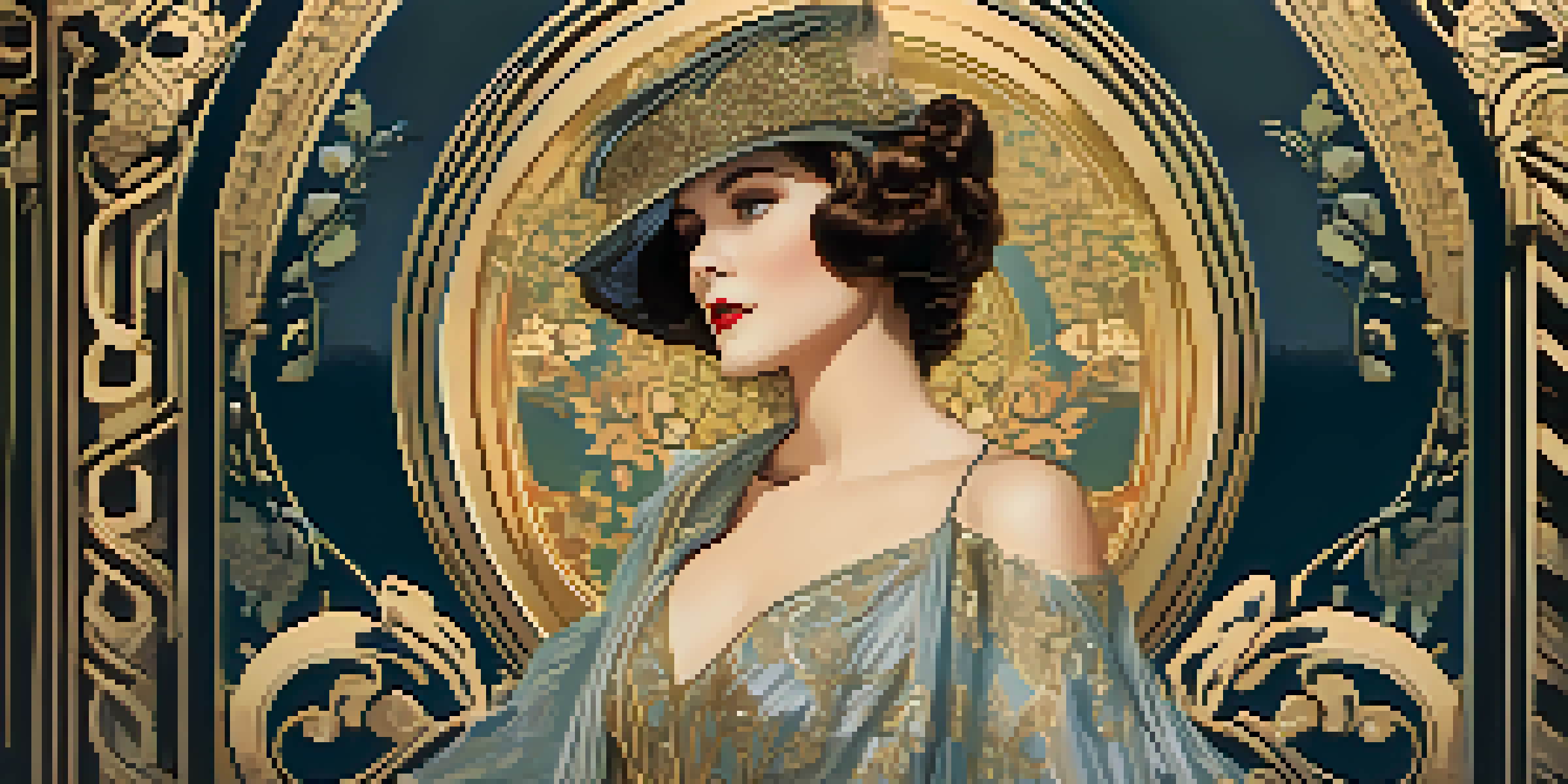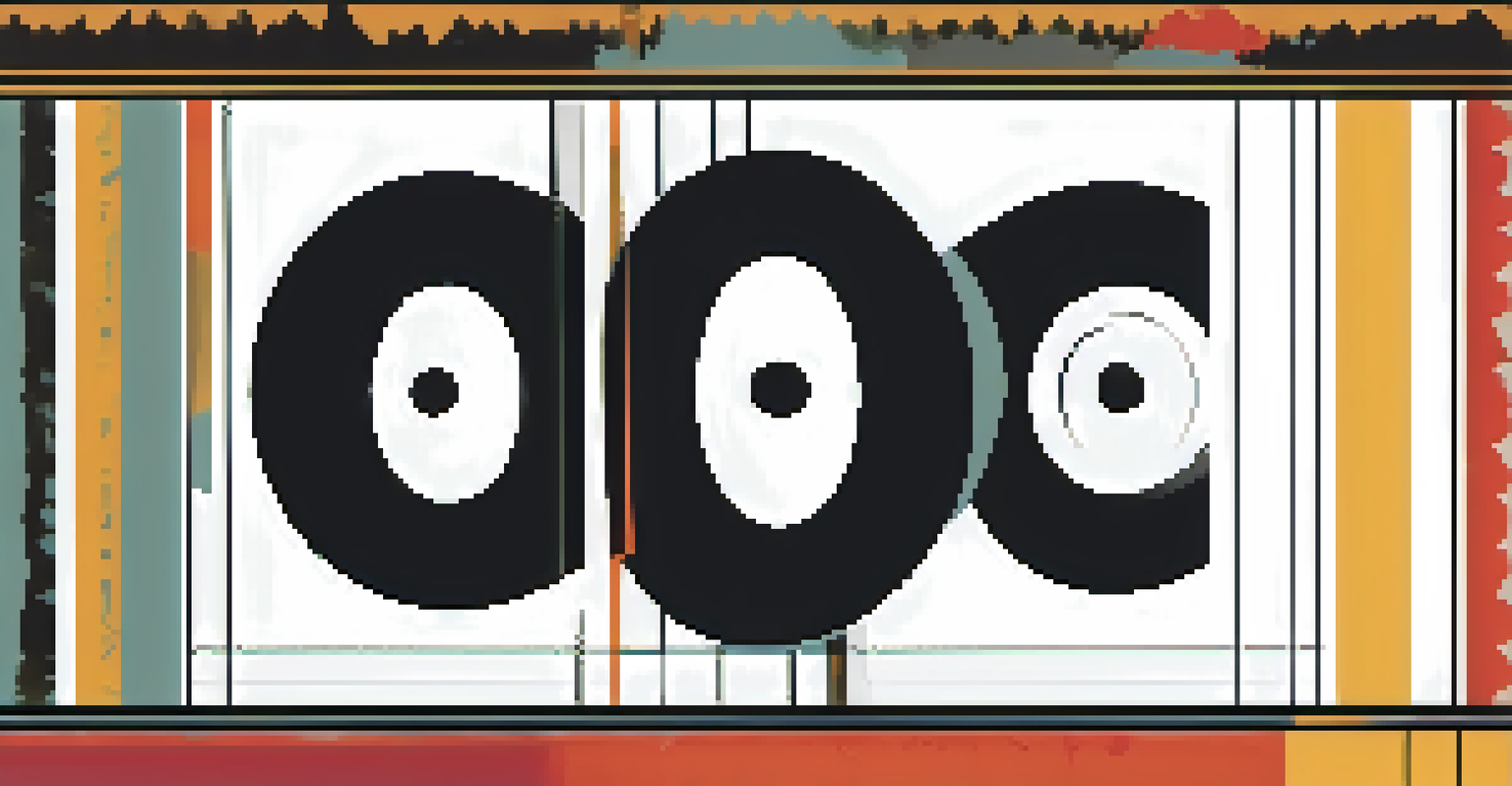The Evolution of Film Poster Design Through the Decades

The Birth of Film Posters: 1890s to 1910s
Film posters first emerged in the late 19th century, primarily as promotional tools for silent films. These early posters were often hand-painted or lithographed, featuring striking imagery to capture the attention of potential viewers. They served not only to advertise but also to embody the essence of the film, encapsulating its themes and tone in a single image.
A film poster is a window into the imagination of a film, capturing its essence and inviting the audience to step inside.
During this period, the focus was on bold illustrations and dramatic typography, reflecting the theatrical roots of cinema. As film technology advanced, so did the artistry behind these posters, with artists experimenting with color and composition to evoke emotion. This era laid the groundwork for the importance of visual storytelling in film marketing.
Interestingly, these early designs also mirrored the broader artistic movements of the time, such as Art Nouveau, which emphasized intricate designs and organic forms. As filmmakers sought to draw audiences into theaters, the artistry of posters became an essential part of the cinematic experience, inviting viewers into a world of imagination.
The Golden Age of Hollywood: 1920s to 1940s
The 1920s to 1940s marked the Golden Age of Hollywood, and film posters reflected the glamour and allure of this era. With the rise of star power, posters began to prominently feature famous actors, making them central to the marketing strategy. This shift not only highlighted the film's star but also created a sense of excitement and anticipation among audiences.

Design during this time was characterized by lavish illustrations and glamorous depictions of movie stars, often capturing their most iconic poses. The use of vibrant colors and dynamic layouts drew viewers in, making the posters almost as captivating as the films themselves. The allure of Hollywood was palpable, and these designs played a crucial role in shaping popular culture.
Evolution of Film Posters Over Time
Film posters have transformed from hand-painted promotional tools in the 1890s to sophisticated designs that reflect cultural trends and technological advancements.
Moreover, this period saw the emergence of innovative techniques, such as the introduction of photographic elements alongside painted illustrations. As a result, posters became more visually complex, mirroring the evolving narrative styles of films. They not only advertised a film but also became a piece of art that fans cherished.
The Rise of Minimalism: 1950s to 1960s
As society evolved in the 1950s and 1960s, so too did film poster design, embracing minimalism. This shift was influenced by the growing popularity of modern art movements and the desire for clean, simple designs that communicated effectively. Posters began to utilize negative space and bold typography, often reducing imagery to its essential elements.
Posters are the art of the cinema. They are the first impression that audiences get of a film, and they can create a world of anticipation.
During this time, iconic films like 'Psycho' and 'Lawrence of Arabia' showcased how less could indeed be more. The minimalist approach allowed designers to create striking visuals that conveyed the essence of a film in a straightforward manner. This was a refreshing change from the busy designs of previous decades, offering a more sophisticated look.
This trend also reflected a broader cultural shift towards simplicity and authenticity in art and design. The focus on essential imagery and concise taglines made posters more accessible, appealing to a wider audience. As film-goers became more discerning, the art of the film poster evolved to meet their changing tastes.
The Explosion of Pop Culture: 1970s to 1980s
The 1970s and 1980s marked an explosion of pop culture, and film posters began to mirror this vibrant era. With the rise of blockbuster films, poster design became more experimental and bold, often incorporating a mix of styles and colors that reflected the eclectic tastes of the time. Graphic design techniques also evolved, paving the way for visually striking imagery that stood out in a crowded marketplace.
Popular films like 'Star Wars' and 'Jaws' featured iconic posters that became cultural phenomena in their own right. These designs often employed dynamic compositions and dramatic visuals, setting the tone for the cinematic experience. The posters were not just promotional tools; they became symbols of the films themselves, deeply ingrained in popular culture.
Impact of Digital Technology
The 1990s digital revolution allowed for intricate designs and enhanced visual storytelling, changing how posters are created and distributed.
Moreover, this era saw the rise of the film franchise, which necessitated a cohesive visual language across multiple posters. Designers faced the challenge of creating unique yet recognizable designs that would resonate with audiences. This led to the development of memorable taglines and visual motifs that have become synonymous with blockbuster cinema.
Digital Revolution and New Aesthetics: 1990s to 2000s
The advent of digital technology in the 1990s revolutionized film poster design. Designers began to leverage computer graphics and digital illustration, expanding their creative possibilities. This shift allowed for more intricate designs and the ability to manipulate images in ways that were previously unimaginable, giving rise to a new aesthetic in poster art.
Posters from this era often featured a blend of photographic realism and digital effects, creating visually stunning results that drew viewers in. Films like 'The Matrix' and 'Titanic' showcased how digital techniques could enhance storytelling through imagery. The posters became immersive experiences, capturing the essence of the film's universe in a single glance.
Furthermore, the rise of the internet changed how posters were distributed and shared. Digital marketing became crucial, and posters were no longer confined to physical spaces. They could be easily shared online, leading to a new wave of fan engagement and the creation of alternative designs and fan art, which further enriched the poster landscape.
The Era of Nostalgia and Retro Revival: 2010s
As we moved into the 2010s, nostalgia became a significant theme in film poster design. Many filmmakers and designers began to draw inspiration from past styles, creating posters that evoked a sense of familiarity and warmth. This retro revival played into the growing trend of reboots and sequels, appealing to audiences' fond memories of beloved films.
Posters from this era often utilized vintage typography and color palettes reminiscent of previous decades, merging old and new in a refreshing way. Films like 'The Grand Budapest Hotel' and 'Guardians of the Galaxy' exemplified how modern films could incorporate classic design elements to create something unique yet nostalgic. These designs tapped into the audience's emotions, making them feel connected to the stories being told.
Nostalgia and Modern Design Trends
Current film posters often blend nostalgic elements with modern aesthetics, tapping into audiences' emotions while embracing diversity and innovation.
Moreover, this era saw the explosion of fan art and alternative posters, where artists reimagined classic films in their own styles. The internet facilitated the sharing of these creations, allowing for a vibrant community of designers and fans. This not only broadened the scope of film poster design but also reignited interest in the artistry behind them.
Current Trends and Future Directions in Film Posters
Today, film poster design continues to evolve, reflecting both technological advancements and cultural shifts. Minimalism and bold graphics are again making a comeback, often combined with digital techniques to create striking visuals. Moreover, the increasing focus on diversity and representation in films is influencing how stories are visually marketed, with more inclusive designs emerging.
Additionally, social media plays a crucial role in shaping modern film poster design. Platforms like Instagram and Twitter have become essential for marketing films, pushing designers to create eye-catching visuals that not only stand out in feeds but also encourage sharing. This has led to innovative approaches, where posters are designed with the intention of going viral.

Looking ahead, we can expect to see further experimentation with augmented reality and interactive designs. As technology continues to progress, the possibilities for film posters are expanding, allowing for a more immersive experience for audiences. The future of film poster design is bright, with endless opportunities for creativity and expression.